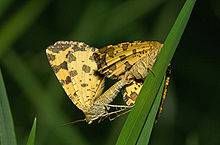Panther tensioner
| Panther tensioner | ||||||||||||
|---|---|---|---|---|---|---|---|---|---|---|---|---|

Panther wrench ( Pseudopanthera macularia ). Copy with a crippled left front wing. |
||||||||||||
| Systematics | ||||||||||||
|
||||||||||||
| Scientific name | ||||||||||||
| Pseudopanthera macularia | ||||||||||||
| ( Linnaeus , 1758) |
The Panther tensioner or Yellow Speckled ( Pseudopanthera macularia ) is a butterfly ( moth ) from the family of the tensioner (Geometridae).
features
The moths reach a wingspan of 23 to 28 millimeters. They have a light to yolk yellow basic wing color, whereby both pairs of wings are covered with numerous large and small, brown, purple shimmering spots, which are mostly arranged in several gappy cross bands. The number and extent of these spots varies. The undersides of the wings are also yellow with spots.
The caterpillars are about 25 millimeters long. They have a green basic color. On the back they have a dark green longitudinal line, parallel to it several, slightly wavy, white lines run laterally. On the sides, at the level of the spiracles, there is a slightly wider white longitudinal line, which is flanked on both sides by a dark green line.
Subspecies
- Pseudopanthera macularia macularia (Linnaeus, 1758)
- Pseudopanthera macularia meridionalis (Galvagni, 1908)
to form
- Pseudopanthera macularia f. transversaria Krul. Spots on the forewings united to ribbons.
- Pseudopanthera macularia f. viridimaculata Ckll. Olive green instead of black spots.
- Pseudopanthera macularia f. albicans Obth. With a whitish base color.
- Pseudopanthera macularia f. fuscaria Stgr. With a dark brown base color.
Synonyms
Venilia macularia (Linnaeus, 1758)
Similar species
- Eurranthis plummistaria (de Villers, 1789)
Occurrence
The panther spanner is widespread from the Iberian Peninsula across Western and Central Europe and the British Isles to Russia . Its distribution area extends in the north to southern Fennoscandia , in the south it can be found from the western Mediterranean islands via Italy and the Balkan Peninsula to the Black Sea region and the Caucasus . The species colonizes sunny areas, such as light forests (forest edges) and open, dry terrain, but also parks.
Way of life
The diurnal moths can often be found when visiting flowers.
Flight and caterpillar times
The moths fly in one generation from late April to early July, the caterpillars are found from July to September.
Food of the caterpillars
The caterpillars feed on various herbaceous plants:
- Spotted dead nettle ( Lamium maculatum )
- Upright ziest ( Stachys recta )
- Ziest ( Stachys spec.)
- Thorny Restharrow ( Ononis spinosa )
- Restockers ( Ononis spec.)
- Mint ( Mentha spec.)
- Common willow ( Salix caprea )
- Red honeysuckle ( Lonicera xylosteum )
- Common hazel ( Corylus avellana )
- Meadow sage ( Salvia pratensis )
- Dead nettle ( Lamium spec.)
- Nordic bedstraw ( Galium boreale )
Food of the moth
The food plants of the moths are better documented than those of the caterpillars. Moths have been observed on the following nectar plants:
- Hairy calf's crop ( Chaerophyllum hirsutum )
- White dead nettle ( Lamium album )
- Creeping buttercup ( Ranunculus repens ) '
- Sharp buttercup ( Ranunculus acris )
- Daisies ( Bellis perennis )
- Winter cress ( Barbarea vulgaris )
- Swamp forget-me-not ( Myosotis palustris )
- Bachbunge ( Veronica beccabunga )
- Meadow-meadow marguerite ( Leucanthemum vulgare )
- Foam herbs ( Cardamine spec.)
- Cypress Spurge ( Euphorbia cyparissias )
- Ruprecht's herb ( Geranium robertianum )
- Germander speedwell ( Veronica chamaedrys )
- Common broom ( Cytisus scoparius )
- Bird vetch ( Vicia cracca )
- Fence vetch ( Vicia sepium )
- Common horseshoe clover ( Hippocrepis comosa )
- Blackberries ( Rubus fruticosus agg.)
- Field Scabious ( Knautia arvensis )
- Meadow sage ( Salvia pratensis )
- Great chickweed ( Stellaria holostea )
- Ground elder ( Aegopodium podagraria )
- True bindweed ( Convolvulus sepium )
- White clover ( Trifolium repens )
- Buckthorn ( Frangula alnus )
development
The pupation takes place in September on the ground in an interspersed with soil web place where the butterflies hatch after a winter.
supporting documents
Individual evidence
- ↑ Pseudopanthera macularia macularia in Fauna Europaea. Retrieved November 11, 2010
- ↑ Pseudopanthera macularia meridionalis in Fauna Europaea. Retrieved November 11, 2010
- ↑ a b c d e f g h i Manfred Koch , Wolfgang Heinicke, Bernd Müller: We determine butterflies. Volume 4: Spanner. 2nd, improved and enlarged edition. Neumann, Leipzig / Radebeul 1976, DNB 780451570 .
- ↑ a b c d e Günter Ebert (Hrsg.): The butterflies of Baden-Württemberg Volume 9 (Spanner (Geometridae) 2nd part), Nachtfalter VII. Ulmer Verlag Stuttgart 2003. ISBN 3-800-13279-6
literature
- Bernard Skinner: Color Identification Guide to Moths of the British Isles , Penguin UK 1999, ISBN 0-670-87978-9

